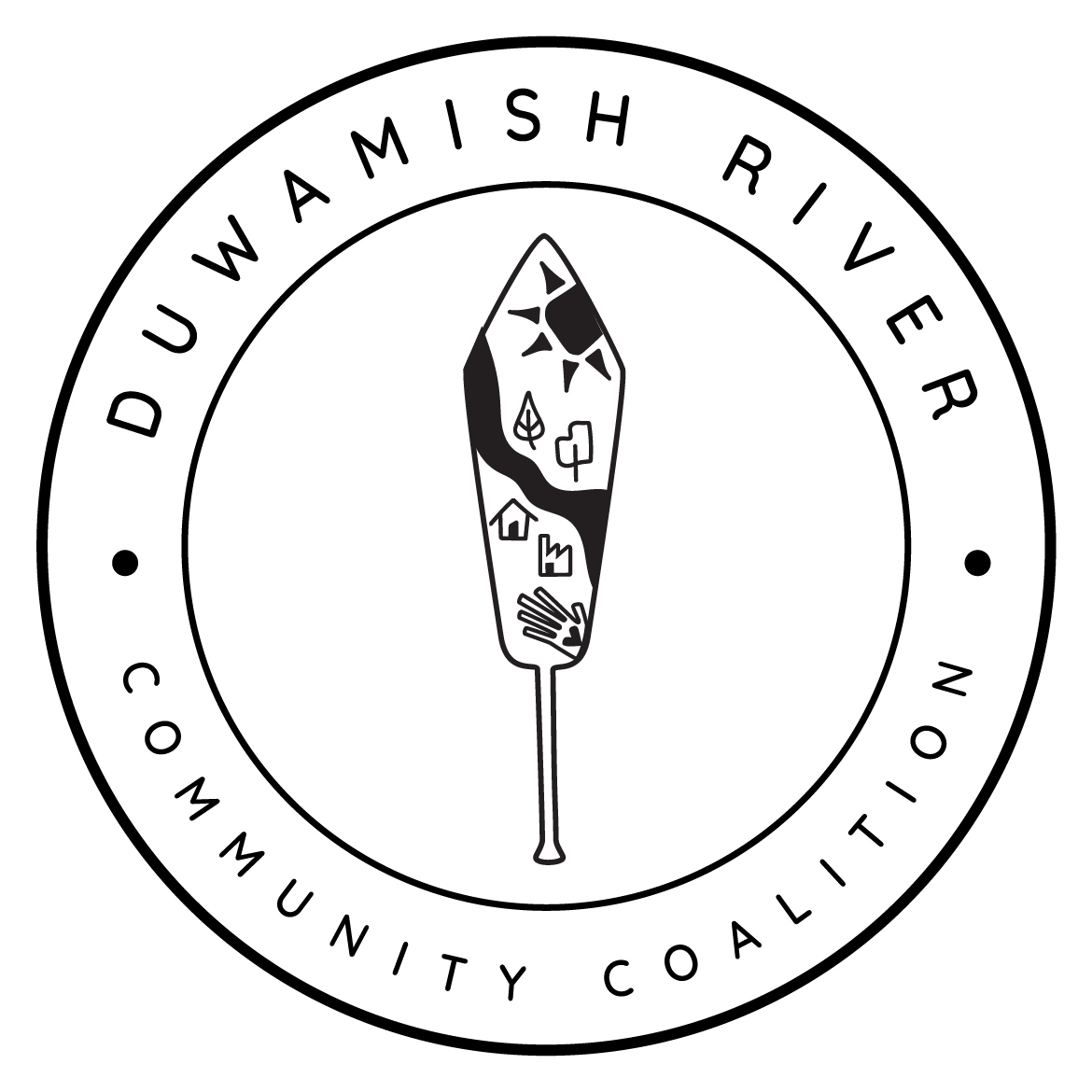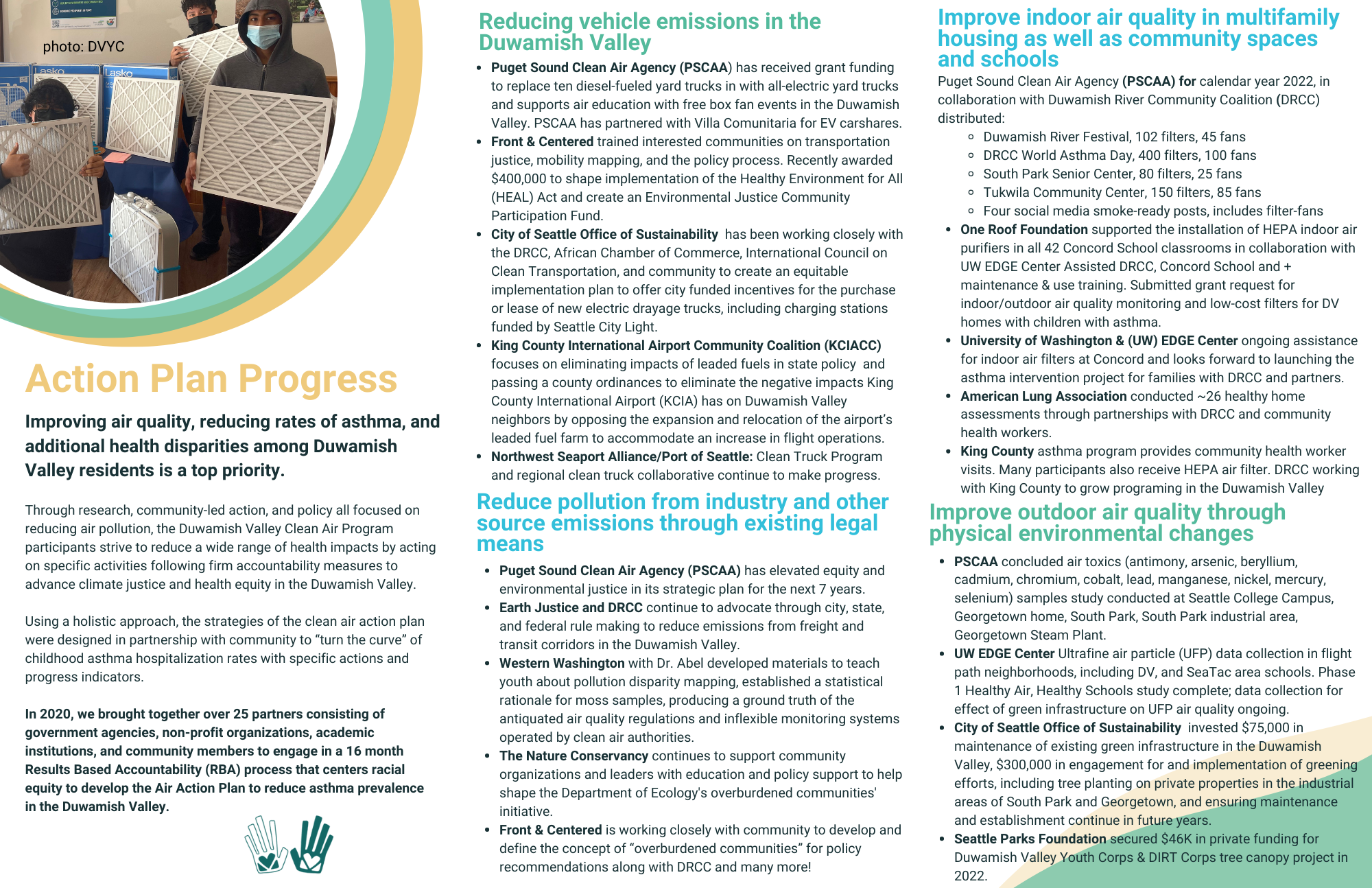Duwamish Valley Clean Air Program
The Duwamish Valley community is constantly exposed to sources of pollution from industries, automobiles, trucks, and other sources.
In the Cumulative Health Impact Analysis (CHIA) published by DRCC / TAG and Just Health Action, Beacon Hill, Georgetown, and South Park (ZIP code 98108) rank higher in air pollution levels compared to other neighborhoods in Seattle.
The environmental exposures identified include the highest concentration of diesel and benzene particles in the air in the entire city. In addition, the Duwamish Valley contains the most polluted waste sites and the Toxic Emissions Inventory sites included in Seattle neighborhoods. CHIA found that Duwamish neighborhoods are affected by diesel particulates, increasing the likelihood that residents will develop asthma. Data tells us that children in South Park and Georgetown were hospitalized more frequently due to asthma conditions.
In fact, the most vulnerable populations (including children, the elderly, and foreign-born residents) among Seattle neighborhoods live in the Duwamish Valley. Data on the South Park and Georgetown neighborhoods also detailed that their life expectancy is eight years shorter than the Seattle average, and 13 years less than the comparatively wealthier neighborhood of Laurelhurst in North Seattle.
Photo by Paul Joseph Brown / Ecosystemphoto.com
Air Quality that Advances Health Equity
In 2019, DRCC relaunched the Clean Air Program. This program seeks to bring together the wide range of private and public agencies with vested interests in air quality and the impact of industry or business in the Duwamish Valley. Bringing these agencies and organizations together allows us to communicate easily and transparently, compare programs, and most importantly, potential outcomes, work together to identify queries, and limit redundancy.
With this series of meetings, we hope to engage the community, scientists, health workers, etc., to move forward together, identify small, individual exercises to promote respiratory health, as well as larger-scale and policy-level actions, and move forward. the needle of varied and hypothetical solutions towards measurable concrete actions.
We have been conducting community science projects, storytelling events, and research in collaboration with our partners. For more information on our efforts, send an email to contact@duwamishcleanup.org
What is the Result Based Accountability (RBA) Process for the Clean Air Action Plan? See this awesome graphic created by Lizette below.
-
The ongoing pandemic is a lesson in climate justice. Alongside experts at the University of Washington, DRCC has been leading the way to understand the relationships between COVID risk, exposure to pollution and dirty air, and how decreased human activity has changed air pollution.
-
DRCC has helped innovate a new way to monitor air quality in the Duwamish Valley: by collecting moss! Duwamish Valley Youth Corps members were trained how to collect moss samples to use as an indicator of air pollution by Forest Service scientists and DIRT Corps members. In all, they collected 80 moss samples from street trees in a 5,300-acre grid covering South Park and Georgetown. Learn more about the study here!
And, you can read our press release!
-
Engaging Duwamish Valley communities is essential in promoting climate justice around our clean air goals. From our “Healthy Home Check-up” program to our Cumulative Health Impact Assessment, DRCC has been innovating important projects and processes for making sure Duwamish Valley communities are heard!
-
Improving air quality and reducing rates of asthma and additional health disparities among Duwamish Valley residents is a top priority as far back as the 2009 Duwamish Valley Vision Plan. DRCC launched the Duwamish Valley Clean Air Program in 2014 per community input. DRCC's Duwamish Valley Clean Air Program is a bottom up community engagement program for improving air quality and advancing health equity in the Duwamish Valley
Download the full report here!
-
Learn more about our Research Study in collaboration with the University of Washington DAISY
What are we doing about it?
DRCC identified addressing air pollution as the top priority for communities based on work done through the Duwamish Vision Plan and Map, Duwamish Valley Clean Air Program, Healthy Home Impact Assessment, Fan Filter Distribution, Proposed Cleanup Plan for the Site of the Duwamish Canal (HIA) and CHIA Superfund. In addition, surveys, community & youth-led research projects like the Moss Study, forming a climate justice platform, mapping of community assets and threats to health, and additional intersecting programs.
Clean Air Program Update: Planning for Results
The Duwamish Valley Clean Air Program is currently applying "turn the curve thinking" to identify the root causes of asthma rates in the Duwamish Valley. In the next two months, this group will uncover and prioritize root causes. After identifying the root causes, otherwise said - the story behind why people have asthma - an action plan, paired with strong performance measures, will be developed to hold actors accountable and turn the curve on asthma rates in the Duwamish Valley.
Clean Air Action Plan Progress
Thank you to the Action Plan Team and Funders
Just Health Action, Cedarplank , Rose Foundation and Puget Sound Clean Air Agency
The study found that areas highly impacted by environmental health disparities (such as high traffic), also had high COVID-19 rates. One of the most significant health hazardous driving this trend was fine particulate matter or PM2.5.
"The disparities are very clear, and there are many possible explanations for them—occupations that cannot be done remotely or require close contact with the public, crowded housing, distrust in healthcare and reduced access to services that have been closed because of COVID restrictions," Farquhar said.












